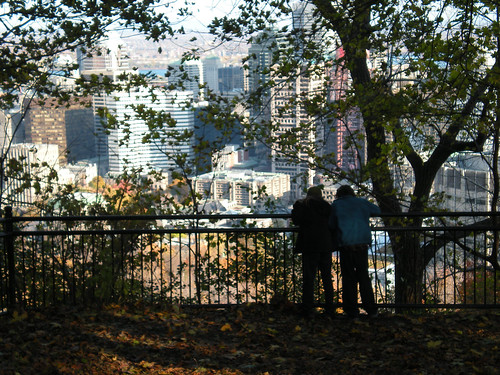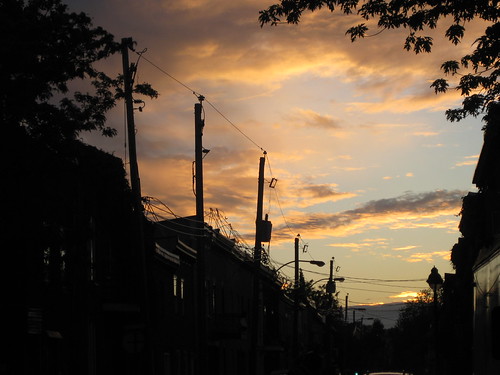Urban economics guru Richard Florida recently set out to discover just how important physical aesthetics are when people choose a place to live (study PDF)
Sure money-making opportunities factor in, Florida insists, as well as social networking and services. But how much of our satisfaction with our neighbourhood can simply be attributed to living in a place we consider beautiful?
Apparently a lot. Florida’s team concluded that a beautiful setting is one of the most important predictors of people’s satisfaction with their community. The only stronger link identified in the study was current economic conditions. Good schools and the ability to meet people and make friends were also important indicators of community satisfaction, but not as positively correlated as residents’ perception that they lived in a beautiful place.
But isn’t beauty fleeting, changeable, and above all in the eye of the beholder?When I studied environmental science we learned that, once upon a time, mountains were considered ugly. People traveling through Europe centuries ago would draw the curtains of their carriages when they approached mountainous terrain. The mountains were uncivilised and harboured unseen threats, from bandits to wild animals. Only later were untamed landscapes romanticized (for instance in Emerson and Thoreau’s writing).
Today if you seach for “beautiful Canada,” half the images Google turns up are of rocky, snow-capped peaks. And one photo is of Montreal’s illuminated skyline at dusk.
Through cluster analysis, Florida’s study found that people who described their community as a beautiful place also rated their neighbourhoods positively in terms of outdoor activities (like parks, playgrounds and trails) which suggests that the participants perceived naturey places as more beautiful.
But is there an innate attraction to living near nature? (Note that access to outdoor activities ranked 6th and physical beauty ranked 2nd terms of importance). Can we build places that satisfy our desire for beauty? Or perhaps a better question would be: can we define a kind of beauty that fits our desire for urban living?
My neighbourhood (NDG around Sherbrooke street) wouldn’t exactly win any beauty contests but I love the unique, shoulder-to-shoulder triplexes, the old trees, the laundry-crossed alleyways and the eclectic, colourful store-fronts. If someone called me up to survey me about NDG’s “beauty and physical setting” I would likely give it a thumbs up.
Which makes we wonder: are Florida’s respondents rating their communities against some “objective” or culturally-created standard of beauty? Or is the correlation so high because people simply have a knack for finding beauty in the places that they love?
As more people world-wide make our homes in cities, I believe that there is a growing sense of urban aesthetics in popular culture (I recently noticed huge black-and-white prints of iron fire escapes for sale at Ikea).
Now that the majority of urbanites no longer work gruelling factory jobs nor live directly beneath smoke-stacks, even industrial landscapes have acquired a certain majesty. Red-brick factories, with their high arched windows, and greystone triplexes that were once merely functional have become coveted real estate.
Of course it isn’t just a matter of learning to appreciate what we’ve got. We can surely add beauty to the city by insisting on quality architecture, creating green spaces, preserving views (for instance of the river and mountain), planting flowers…
Florida’s study may not offer much advice for urban planers, but it does confirm that people’s relationship with their community is based on attraction as well as utility.



7 comments
I just can’t help myself but I find the traditional poor neighborhoods of Montreal such as Saint Henri, The Point, The Plateau, Hochelaga, good old grid Verdun, etc, to be stunning and of never ending fascination. No matter how badly run down parts of these neighborhoods can get they possess some uncanny inherent nature that allows them to be restored magnificently. Can’t say that about most stuff built after the 40’s – most of it tends to look as good as it will ever be when new, and does not flow with the times very well. And it does signal a time when the building of the city began going from the hands of “artisans” to “developers”. Developers have never learned how to build in that uncanny thing that one might call “soul”.
Well said, Neath!
to add to the Florida logic: is it possible that population increase is good for economic growth as well (methinks ‘Yes’)?
And if aesthetic greatness brings people, which brings $$$, which brings more people, thus the cornerstone of any Great City may very well be found in the maxim of Keats ‘Ode to a grecian Urn’:
“Beauty is truth, truth beauty,” – that is all/Ye know on earth, and all ye need to know.’
I left beautiful Vancouver — surely, a city with an overdose of naturey places if ever there was one — for the much more urban Montreal. I miss the ocean and the mountains and the smell of the rainforest, which are all very good for the soul. But despite Vancouver’s glorious nature, Montreal is a much more beautiful city.
My early days were spent on a farm on a dirt road on an island far from civilization. And I had learned, somehow, the popular view that nature was pristine and perfect, and our presence was a blight on this planet as we foolishly destroyed nature and called it progress and better. But living in Montreal which has such many beautiful spaces and buildings and neighbourhoods, in a setting where nature is less impressive than B.C., reminds me that yes, a city can be more beautiful and interesting than the nature it replaced. I love going down to the Old Port and looking at the built-up river and the buildings of Old Montreal and thinking: wow, what a beautiful space this is, the perfect combination of a majestic river and some very pretty human interventions.
Of course, on the other hand there’s boul. Taschereau… :)
In reply to Neath, Pointe-St-Charles, the Plateau, Verdun, Hochelaga, etc were not built by artisans, but by developers as well, just from a different era, with different values and a different mind set. As much as I dislike most architecture and planning coming from the late 40’s to the late 80’s, I still think architecture and “planning” from the turn of the century (that is, the turn of the 20th century) is now idealized and embraced in a fairy-tale like approach. Don’t get me wrong, I find the use of stone, brick, wood, iron, etc very appealing, however, I cannot dislike new constructions such as the ones in the old Montreal, or la cite du multimedia, or wherever else you might find it. The only reason why we appreciate the older architecture in Montreal, is because we now endorse it as giving the city its distinct character… I personally think that Montreal gains its charm (as opposed to beauty, but let’s not get too technical here) from the clash of old vs. new, or new inserted between old.
Before I moved to Montreal I would always visit and feel ‘comfy’ somehow. I never really understood why until I’d lived here for a year or so and I began to single out- one by one- the various little details that made me feel that way.
The traffic signals: Simple, black.. they fit in without drawing undue attention. Street furniture: Benches, bus shelters, garbage cans everywhere that don’t draw attention yet if you do notice them, they look good and they work! Storefronts and signage: Business owners generally take pride and are creative without adhering to any set style thus making most streets.. stylish! Sidewalks: uncluttered by junky paper boxes and crappy weenie wagons yet cluttered with people and terrasses that you don’t mind walking into/through/around. Squares/parks/parkettes/pocket parks: Everywhere, including downtown, you don’t notice most of them because they are so numerous. Hydro poles: nonexistant on most major streets.
Montreal gets so many of the little details right; dozens of minor details that add up to major overall loveliness. In most of cities that I’ve lived in the highlights are so noteworthy because they are so relatively few.. Here, the lowlights are so noteworthy because they are so relatively few.
We are such a wonderful city!
The interesting part of comparing Montreal to other cities is that Montreal, for me, has more attractive neighborhoods than most cities, a greater choice of cool places to live. Most cities have one or two neighborhoods that are amazing but get taken over quickly by their own popularity. Here we still have whole neighborhoods with relatively cheap rent that don’t necessarily attract quick speculation. These are only a few reasons why I just love this city so much and believe we can do astonishing things here if we don’t let aggressive short term development decide our future.
All of your comments want to make me move to Montreal. I lived in Seattle in the early 80’s before Microsoft and it was a city that managed to be naturey and urban and a little raw around the edges and very human, probably because of the neighborhoods. It was a great place. Now, just a lot of money.